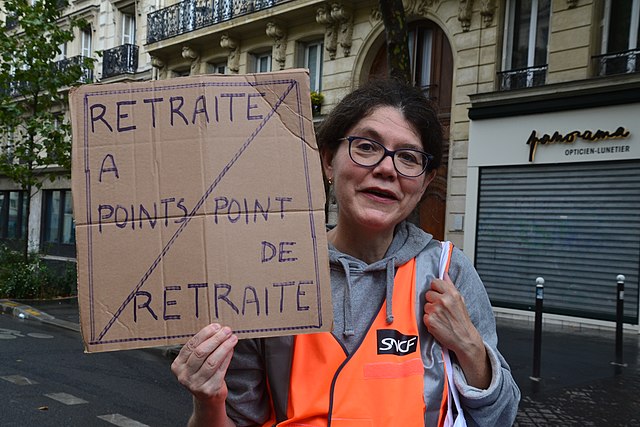Are the retirement reform program protests in France destined for success?
 "Manifestation à Paris contre la 'réforme' des retraites" by Jeanne Menjoulet, licensed under CC BY 2.0
"Manifestation à Paris contre la 'réforme' des retraites" by Jeanne Menjoulet, licensed under CC BY 2.0
While the phrase “national sport” invokes images of hockey rinks and football fields for Canadians and Americans respectively, this phrase means something quite different in France, where many consider the national sport to be protest. And if protest is France’s national sport, it is certainly in season. Throughout the beginning of 2023, streets across France have been covered with protesters pushing back on the Macron government’s proposed retirement system reforms. This current wave reflects a similar theme to the yellow vest protests of 2018: the seeming disconnect between the Macron government and working-class people in France. However, where the yellow vest protests were successful in disrupting public life in France and forcing the Macron government to backtrack on its proposed fuel tax, the reform protests have yet to make such strides. As protests continue across the country and the future of the Macron government’s retirement reforms remains uncertain, it is critical to understand why the yellow vest protesters were successful and whether they could serve as an example for future mobilizations in France and globally.

What was so special about the Yellow Vest protesters?
Characterized by their popular uniform, the 2018 protest movement was known as les gilets jaunes or yellow vests. While the movement started in response to a proposed increase of the fuel tax, it quickly sparked a larger national discussion on the divide between the rich and poor— notably between the country’s affluent president and the working class masses. Protesters pointed to policies, such as the decrease in wealth tax for France’s most affluent and the aforementioned gas tax, which disproportionately affected working-class rural people as evidence that the president was out of touch with his people. Critics also noted Macron’s particular disconnect with non-urban working-class people, many of whom have limited access to public transport which worsens the effects of high gas prices.
In keeping with the movement’s populist appeal, the yellow vest protesters followed a somewhat unorthodox path to legislative success. Although France is known for having successful protests and strikes due to its strong labour union presence, many of the workers taking part in the yellow vest protests came from non-unionized fields. In the absence of formal and traditional organizations, the yellow jacket protesters simply relied on strength in numbers and a willingness to fight back in order to invite change. The yellow jackets blocked streets, closed down metros, and instigated sometimes violent interactions with police, preventing ‘business as usual’ across the country. This unorthodox approach caught the attention of the media, both across France and worldwide. The movement sparked a national conversation on the disconnect between different sectors and classes of French society. It was largely thanks to the media attention that the yellow vest movement was able to make inroads beyond the re-evaluation of the gas tax.

A similar situation for the retirement reform protests?
Flash forward a few years to the current upheaval against the government’s proposed pension reforms. While this current wave of protests reflects similar sentiments that the Macron government is disconnected from large swaths of France’s working population, it is important to note some key differences between the two movements. While the yellow jacket protesters were largely rural-based, the retirement reform protests have been more widespread throughout France. This is explained by the fact that most of France’s urban population would have been largely unaffected by a fuel tax increase given their access to public transport. Furthermore, because many retirement reform protesters are unionized, unions are playing a central role in organizing protests and negotiating with legislators. Perhaps most importantly, the retirement reform protests have been strictly in response to the government’s proposed changes to the national pension system. This means that legislative negotiation is happening in the frame of this specific issue, with the ultimate goal of preventing the reform from being enacted. This approach is vastly different from the general anti-establishment sentiment that characterized the yellow jacket protesters even after the fuel tax increase was postponed.
Which approach works better?
Returning to the question of whether the yellow jacket protests can serve as a model for movements like the retirement reform protests, it is important to lean on the ideas of experts in collective action. According to Mancur Olsen, the author of The Logic Of Collective Action, collective action requires a group, shared values, consensus regarding methods, and an end goal. Olsen explains that collective action is most effective when all participants have significant gains to be made and when there are means to ensure that participants do not reap the benefits without actively participating or paying the potential costs. The best way to mitigate these challenges, particularly with larger collective action groups, is through organizations such as labour unions, which can help establish a precise goal and ensure active participation.
Following Olsen’s theory, the yellow vest movement appears to be an exception to the rule of collective action. Even in this exceptional case where a protest movement was able to succeed without formal group organization, the limits of collective action are visible. After the movement achieved its original goal of preventing the fuel tax increase, the purpose of the movement became less clear, and from thereon the legislative success was limited. This fact is crucial. Successful collective action requires more than creating buzz around an idea. If it did not, we could consider every Instagram infographic which “spreads awareness” for a given cause without actually enacting any change an example of successful collective action. The yellow vest movement should therefore serve as a lesson to the retirement reform protest and other movements worldwide that starting a conversation is only the first step of social mobilization. If a movement is to successfully enact change, it must not lose sight of its primary goal.
Edited by Erika Mackenzie.
Featured image “Manifestation contre la ‘reforme’ des retraites” courtesy of Jeanne Menjoulet is licensed under CC BY 2.0
.
